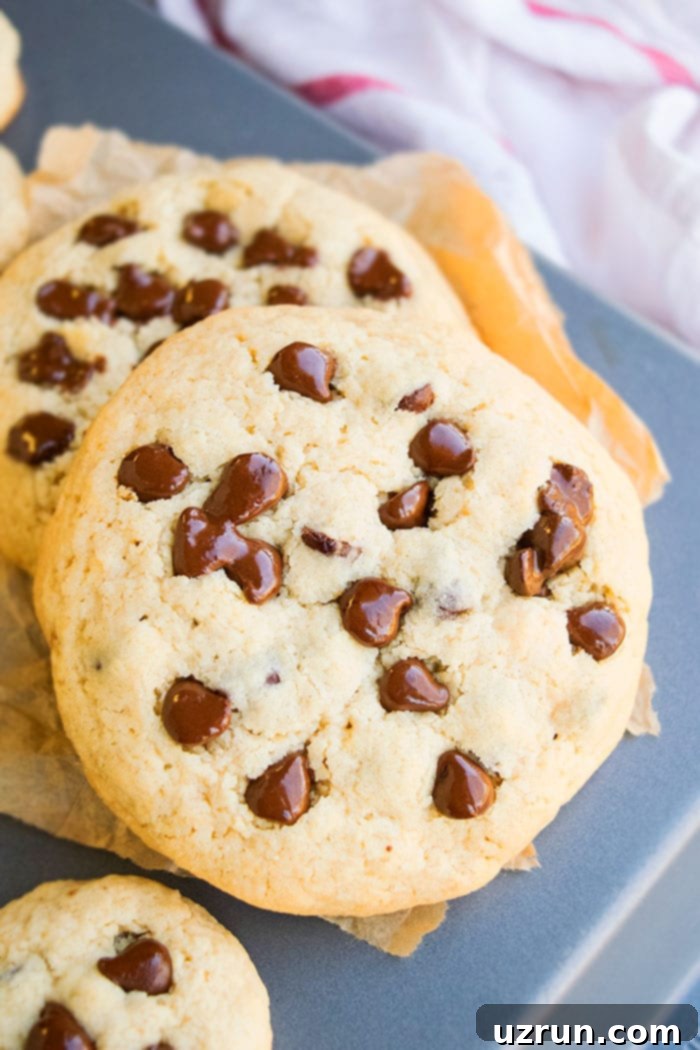The Ultimate Recipe for Best Soft, Chewy & Jumbo Chocolate Chip Cookies from Scratch
There’s nothing quite like the comforting aroma and irresistible taste of warm, homemade chocolate chip cookies. But not just any chocolate chip cookies – we’re talking about the absolute best soft and chewy chocolate chip cookies you can imagine, crafted from scratch with simple ingredients. This recipe promises jumbo-sized, bakery-style delights that are incredibly quick and easy to prepare, delivering that perfect balance of a golden, slightly crisp edge and a wonderfully gooey, melt-in-your-mouth center. Prepare yourself for a cookie experience that will redefine your expectations!
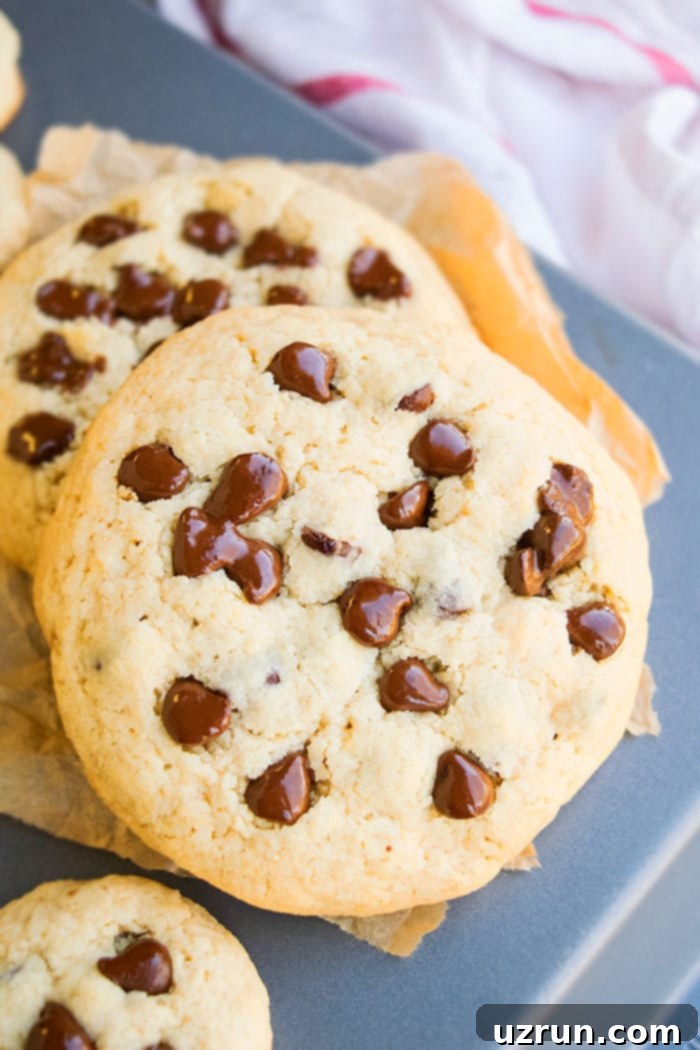
Key Ingredients for Perfect Soft & Chewy Cookies
Crafting the perfect batch of soft and chewy chocolate chip cookies starts with understanding the role each ingredient plays. Using high-quality, fresh ingredients and having them at the correct temperature will make a significant difference in your final product.
- Cake Flour: This is a secret weapon for achieving that incredibly soft, tender crumb. Cake flour has a lower protein content than all-purpose flour, which means less gluten development, resulting in a more delicate cookie.
- Brown Sugar: Essential for chewiness and depth of flavor. The molasses in brown sugar adds moisture to the dough, preventing the cookies from drying out and contributing to their signature bendy texture.
- Granulated Sugar: While brown sugar brings chew, granulated sugar contributes to the crisp edges and helps the cookies spread slightly. The combination of both sugars creates a balanced texture.
- Chocolate Chips: The star of the show! Semisweet chocolate chips are classic, offering a perfect balance of sweetness and rich chocolate flavor. We’ll discuss other types in the variations section.
- Unsalted Butter: Using unsalted butter allows you to control the exact amount of salt in your recipe. It’s crucial for achieving a smooth, creamy dough when properly creamed with sugar. Ensure it’s at room temperature for optimal results.
- Eggs: Eggs act as a binder and add richness and moisture. Like butter, room temperature eggs emulsify better with other ingredients, leading to a more uniform dough.
- Vanilla Extract: A splash of pure vanilla extract enhances all the other flavors, adding a warm, aromatic depth that’s synonymous with classic chocolate chip cookies.
- Baking Soda: This leavening agent helps the cookies rise and spread, contributing to their soft texture and slightly golden appearance.
How to Make the Best Easy Chocolate Chip Cookies from Scratch
Follow these simple steps to create bakery-worthy jumbo chocolate chip cookies right in your own kitchen. Precision and care at each stage will ensure magnificent results!
- Prepare Dry Ingredients: In a medium mixing bowl, thoroughly whisk together the cake flour and baking soda. Whisking ensures that the leavening agent is evenly distributed, which is key for a consistent rise. Set this bowl aside.
- Cream Butter and Sugars: In a separate, large mixing bowl, using an electric mixer (stand or hand-held), cream together the softened unsalted butter, brown sugar, and granulated sugar. Beat on medium speed for 2-3 minutes until the mixture is light, fluffy, and pale in color. This step incorporates air into the butter, which is vital for cookie texture.
- Add Wet Ingredients: Beat in the large room temperature egg until it’s fully incorporated into the butter and sugar mixture. Scrape down the sides of the bowl to ensure everything is well combined. Then, stir in the vanilla extract until just blended.
- Combine Wet and Dry: Gradually add the reserved flour mixture to the wet ingredients. Mix on low speed until just combined. Be careful not to overmix, as overmixing can develop gluten, leading to tougher cookies. A few streaks of flour are fine; they will disappear during the next step.
- Stir in Chocolate Chips: Gently fold in the semisweet chocolate chips using a spatula. Distribute them evenly throughout the dough.
- Chill the Dough (Optional but Recommended): If your dough feels too soft to handle, or if you prefer a richer flavor and thicker cookie, cover the bowl with plastic wrap and chill it in the refrigerator for 30-40 minutes. This helps prevent excessive spreading during baking and allows the flavors to deepen.
- Portion and Prepare for Baking: Divide the chilled (or unchilled, if firm enough) dough into 6 equal portions for jumbo cookies. Roll each portion into a smooth ball. Line a large baking sheet with parchment paper. Place the cookie dough balls on the prepared tray, ensuring ample space between each cookie to allow for spreading.
- Bake to Golden Perfection: Preheat your oven to 350°F (175°C). Bake the cookies for 18 to 20 minutes, or until the edges are golden brown and firm, but the centers still look slightly soft and puffed. Remember, cookies continue to cook slightly as they cool on the hot baking sheet.
- Decorate (Optional): Immediately after removing the baking tray from the oven, if desired, gently press a few extra chocolate chips onto the tops of each warm cookie. This creates that iconic “bakery-style” appearance with perfectly melted chocolate puddles.
- Cool and Enjoy: Let the cookies cool on the baking sheet for 5-10 minutes before transferring them to a wire rack to cool completely. This crucial step allows the cookies to set and prevents them from falling apart. Once cooled, they are ready to be devoured!
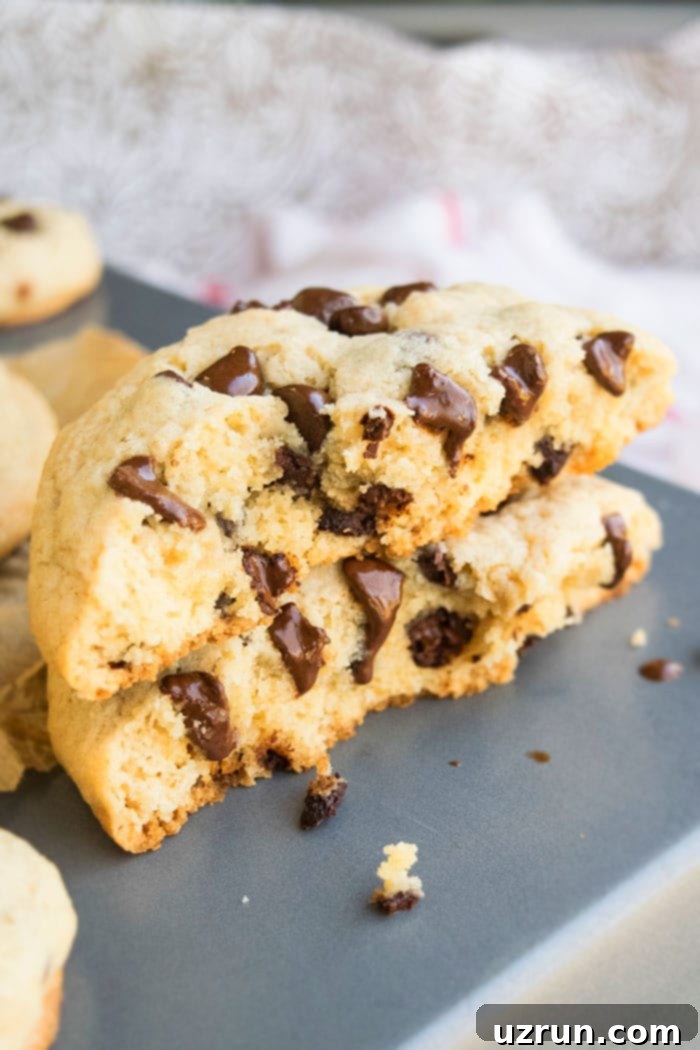
Expert Tips and Techniques for Flawless Chocolate Chip Cookies
Achieving consistently perfect cookies often comes down to mastering a few key techniques and understanding why they matter. Here are my top tips for the ultimate soft and chewy chocolate chip cookies:
- Chilling the Cookie Dough: This isn’t just about making the dough easier to handle. Chilling for 30-40 minutes (or even up to 24 hours) allows the butter to re-solidify, which slows down spreading during baking, resulting in thicker cookies. More importantly, it gives the flour time to fully hydrate and the flavors to meld, leading to a richer, more complex taste.
- Choosing Your Chocolate: While semisweet chocolate chips are a classic choice and taste fantastic, don’t be afraid to experiment! Dark chocolate chips offer a deeper, more intense flavor, while milk chocolate chips add extra sweetness. You can also use chopped chocolate bars for a more artisanal, varied melt.
- The Power of Cake Flour: For the absolute best soft texture, cake flour is non-negotiable in this recipe. Its lower protein content prevents excessive gluten formation, which can lead to tough cookies. If you don’t have cake flour, you can create a substitute by removing 2 tablespoons of all-purpose flour per cup and replacing it with 2 tablespoons of cornstarch, then sifting well.
- Batch Size Adaptability: This recipe is incredibly versatile. It can easily be doubled or even tripled to make a larger batch for parties, bake sales, or simply stocking your freezer with cookie dough. Adjust baking times slightly for larger quantities.
- Jumbo vs. Regular Cookies: This recipe is designed for impressive jumbo cookies. However, you can use the exact same dough to make 12 regular-sized cookies. Simply reduce the baking time to approximately 10-12 minutes, or until the edges are golden.
- Room Temperature Ingredients are Key: This is a crucial step often overlooked. Butter and eggs at room temperature emulsify much more easily, creating a smooth, homogenous dough that traps air effectively during creaming. This trapped air expands in the oven, contributing to a lighter, softer cookie. Cold ingredients will result in a lumpy, less cohesive dough.
- Stick to Unsalted Butter: Always use unsalted butter when baking, unless a recipe specifically calls for salted. This allows you complete control over the salt content, ensuring your cookies aren’t overly salty and perfectly balance the sweetness.
- Don’t Skip the Sugar Blend: Both granulated sugar and brown sugar are essential. Granulated sugar promotes crispness and spread, while brown sugar adds moisture, chewiness, and a subtle caramel flavor. Replacing one with the other will significantly alter the texture and taste.
- Parchment Paper is Your Friend: Always line your baking sheets with parchment paper or a silicone baking mat. This prevents sticking, ensures even baking, and makes for super easy cleanup.
- Don’t Overmix the Flour: Once you add the flour mixture, mix only until just combined. Overmixing develops the gluten in the flour, which can lead to tough, dense cookies instead of soft and chewy ones.
Exciting Chocolate Chip Cookie Variations to Try
While the classic soft and chewy chocolate chip cookie is perfect as is, it also serves as an excellent base for numerous creative variations. Get inspired and make these cookies your own!
- Amp Up the Chewiness: For an even chewier texture, mix in ½ cup of finely shredded coconut into the cookie dough along with the chocolate chips. The natural moisture and texture of the coconut add an extra dimension.
- Add a Nutty Crunch: Incorporate ⅓ cup of crushed walnuts, pecans, or almonds into the cookie dough for a delightful textural contrast and nutty flavor. Toasting the nuts lightly beforehand can enhance their aroma.
- Banana Lovers Rejoice: For those who enjoy a cake-like texture and the delightful pairing of banana and chocolate, try these Banana Chocolate Chip Cookies. They offer a unique twist on the classic.
- Peanut Butter Perfection: If you’re a fan of peanut butter, you absolutely must try my Peanut Butter Chocolate Chip Cookies. The combination of salty peanut butter and sweet chocolate is irresistible.
- Cake Mix Shortcut: For a super easy variation, consider a cake mix base. Use a yellow cake mix instead of chocolate cake mix in these Cake Mix Chocolate M&M Cookies and simply replace the M&M candies with your favorite semisweet chocolate chips.
- Stuffed Cookie Surprise: Take your cookies to the next level by stuffing them! Before baking, flatten each cookie dough ball slightly, place an Oreo cookie or a caramel square in the center, then wrap the dough around it to fully enclose the filling.
- Transform into Cookie Bars: Don’t feel like scooping individual cookies? Press this entire cookie dough into a greased and floured 9×9 inch square baking pan. Bake at 350°F (175°C) for approximately 25-30 minutes, or until a toothpick inserted into the center comes out clean. Cut into bars once cooled.
- Decadent Double Chocolate: Once your baked cookies have completely cooled, melt some extra chocolate (dark, milk, or white). Dip each cookie halfway into the melted chocolate, then place them on parchment paper to set. This creates a beautiful and rich double chocolate effect.
- White Chocolate Dream: For a sweeter, creamier chocolate experience, simply swap out the semisweet chocolate chips for an equal amount of high-quality white chocolate chips.
- Create a Cookie Cake: Press the cookie dough into an 8×2 inch round cake pan, smoothing the top. Bake at 350°F (175°C) for about 25-30 minutes, or until golden brown and set. Once cooled, decorate with your favorite frosting and sprinkles for a celebratory treat, similar to my Chocolate Chip Cookie Cake (With Cake Mix).
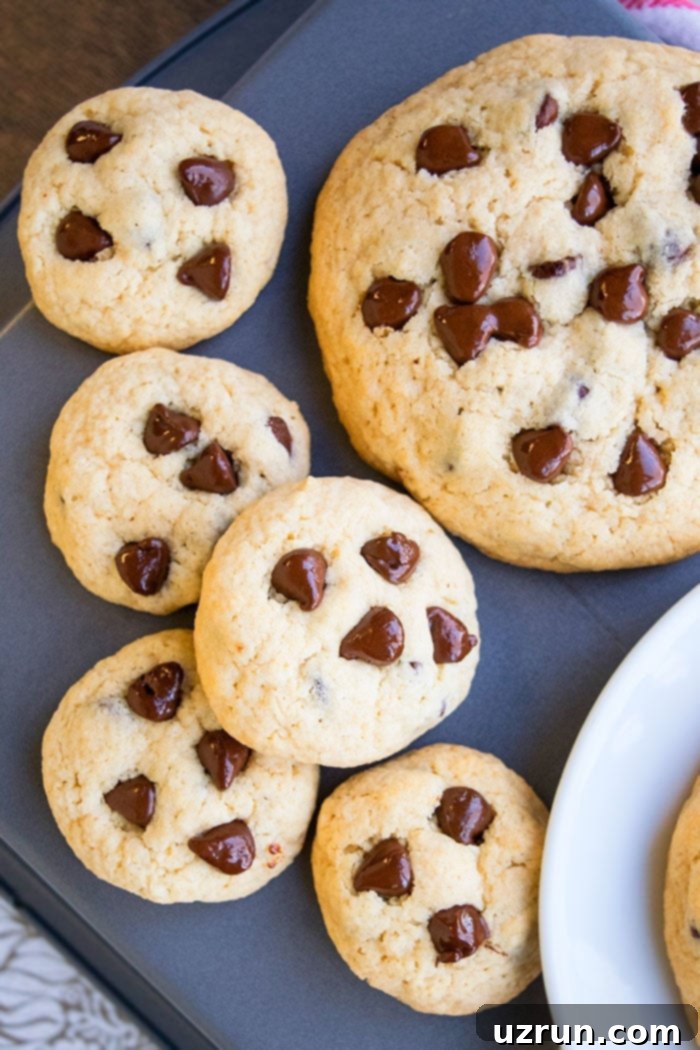
The Science Behind Perfectly Chewy Chocolate Chip Cookies
Achieving that coveted soft and chewy texture isn’t accidental; it’s a result of a few key factors working in harmony. Understanding these principles will help you troubleshoot and consistently bake amazing cookies:
- High Moisture Content is Key: Chewy cookies retain more moisture. This recipe is designed with ingredients that contribute and hold onto moisture, such as brown sugar and eggs. The goal is to minimize moisture evaporation during baking, keeping the interior soft and pliable.
- Dough Consistency Matters: A slightly stiffer cookie dough that doesn’t spread too much is ideal for chewiness. This allows the cookies to bake up thicker, which means less surface area is exposed to the heat, reducing moisture loss. Chilling the dough also helps achieve this consistency.
- Size Plays a Role: Larger, thicker cookies (like our jumbo style) naturally retain more moisture than smaller, thinner ones. The greater mass means the heat takes longer to penetrate the center, resulting in a perfectly soft interior while the edges crisp up. This reduced evaporation is crucial for chewiness.
- Brown Sugar is Super Important: This ingredient is a chewy cookie’s best friend. Brown sugar contains molasses, which is hygroscopic, meaning it attracts and retains moisture. This added moisture keeps the cookies soft and pliable even after cooling, giving them that delightful bend. Granulated sugar, while necessary for spread and crispness, doesn’t offer the same moisture retention.
- Precise Baking Time is Critical: Over-baking is the arch-nemesis of a chewy cookie. Baking them for too long will dry them out, making them firm and crisp. Cookies are typically ready when their edges are golden brown and set, but the centers still look slightly soft and maybe even a little “undercooked” or puffed. They will continue to set as they cool on the hot baking sheet, so removing them slightly early is key to chewiness.

Troubleshooting: Why Did My Cookies Come Out Flat?
Flat cookies are a common baking frustration, but often, the cause is easily identifiable and fixable. Here are the main reasons why your cookies might not be rising as they should and how to prevent it:
- Improper Measurements: Baking is a science, and precise measurements are crucial. Too little flour or too much butter can lead to a dough that is too wet and spreads excessively. Use a kitchen scale for accuracy, especially with flour.
- Ingredients Not at Room Temperature: This is a big one! Cold butter and eggs do not cream properly with sugar. When butter is cold, it won’t incorporate enough air, resulting in a denser dough that spreads more in the oven. Room temperature ingredients emulsify better, creating a light, aerated dough that holds its shape.
- Inaccurate Oven Temperature: An oven that isn’t calibrated properly can cause issues. If your oven runs too low, cookies will spread before they set. If it’s too high, they might bake too quickly on the outside and remain raw inside, or spread unevenly. Use an oven thermometer to verify and calibrate your oven’s temperature.
- Warm Dough or Kitchen: If your dough is too warm before baking (either from sitting out too long or a hot kitchen environment), the butter in the dough will melt too quickly in the oven, causing the cookies to spread excessively before they have a chance to set. Always chill your dough if it feels too soft or your kitchen is particularly warm. A quick 10-15 minutes in the freezer can also help firm it up.
- Old or Inactive Leavening Agents: Baking soda loses its potency over time. If your baking soda is old (typically past 6-12 months after opening), it won’t produce enough carbon dioxide to help your cookies rise, leading to flat results. Test your baking soda by adding a teaspoon to a few tablespoons of vinegar; it should bubble vigorously.
- Overmixing the Dough: As mentioned before, overmixing flour can develop too much gluten, which makes cookies tough. It can also incorporate too much air, which initially might seem good, but can then lead to a collapse and spreading.
- Greased Baking Sheets: Unless specified, avoid greasing your baking sheets directly. This adds extra fat, which can cause cookies to spread more. Instead, always use parchment paper or a silicone baking mat.
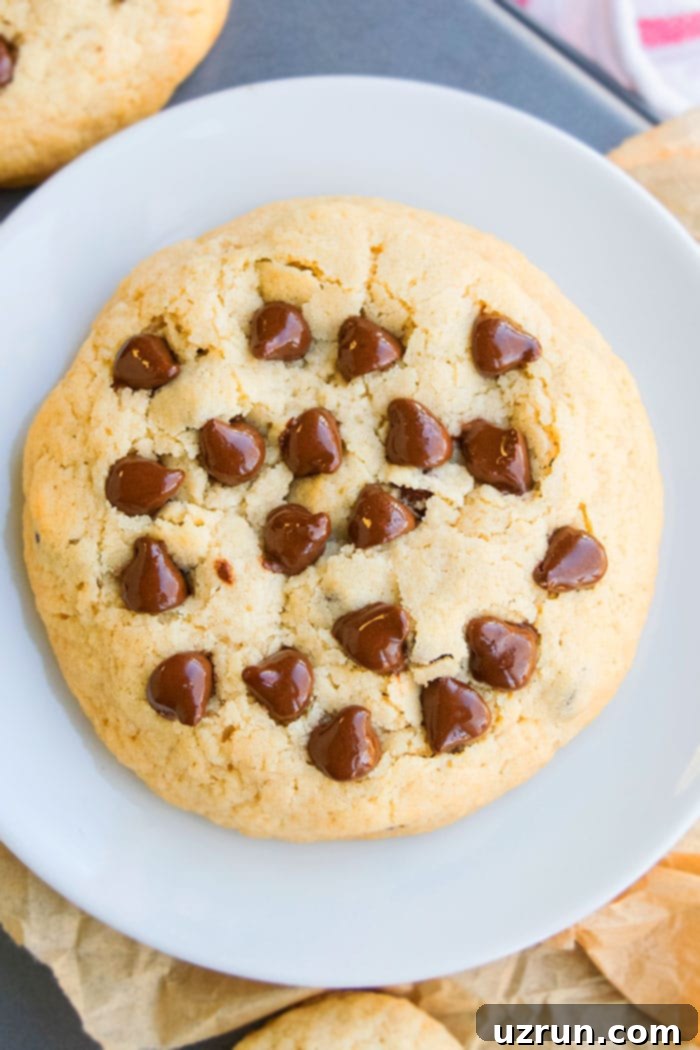
Recipe FAQs
To maintain optimal softness, store your cookies in an airtight container at room temperature. For an extra boost of moisture, place a slice of plain bread (like sandwich bread) in the cookie jar with them. The cookies will absorb moisture from the bread, keeping them wonderfully soft, while the bread will become hard. Just be sure to replace the bread slice every day or two.
Yes, you absolutely can transform these into double chocolate chip cookies! If adding cocoa powder, it’s generally best to replace a small portion of the flour with cocoa powder (e.g., replace ¼ cup of flour with ¼ cup of unsweetened cocoa powder). Additionally, you may need to add 1-2 tablespoons of milk or water to the dough, as cocoa powder tends to absorb moisture, which could make the dough too thick or dry. Mix until the dough reaches a good, manageable consistency.
Once completely cooled, store your jumbo chocolate chip cookies in an airtight container at room temperature for up to 3 days. They will maintain their soft and chewy texture. For longer storage, see the freezing tips below.
Yes! This recipe is excellent for freezing. To freeze dough, scoop the cookie dough balls onto a parchment-lined baking sheet and flash freeze for about an hour until solid. Transfer the frozen dough balls to a freezer-safe bag or container and store for up to 3 months. Bake directly from frozen, adding a couple of minutes to the baking time. To freeze baked cookies, ensure they are completely cool, then place them in an airtight freezer-safe container or bag for up to 1-2 months. Thaw at room temperature before enjoying.
For that perfect bakery aesthetic, the trick is to add extra chocolate chips right after baking. As soon as you pull the hot cookies from the oven, gently press a few more chocolate chips onto the top of each cookie. The residual heat will melt them slightly, creating those beautiful, glistening pools of chocolate that make homemade cookies look professionally made.
More Delicious & Easy Cookie Recipes
If you loved this chocolate chip cookie recipe, you might enjoy exploring these other easy and delightful cookie creations:
- Fresh Strawberry Cookies
- Chocolate Sugar Cookies (Cut Out)
- Easy Nutella Cookies
- Leftover Candy Cookies (Halloween)
Recipe
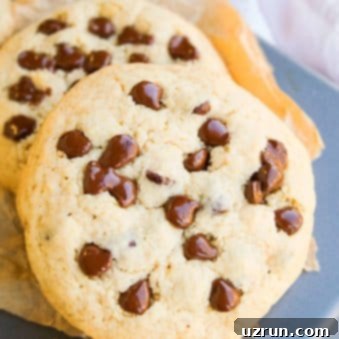
Best Soft Chewy Chocolate Chip Cookies (Jumbo)
Abeer Rizvi
Pin Recipe
Want to Save This Recipe?
Enter your email & I’ll send it to your inbox. Plus, get great new recipes from me every week!
By submitting this form, you consent to receive emails from CakeWhiz
Ingredients
- 2-¼ cup Cake flour
- 1 teaspoon Baking soda
- ¾ cup Unsalted Butter Softened to room temperature
- ¾ cup Light Brown sugar Packed
- ½ cup Granulated sugar
- 1 Large Egg At room temperature
- 1 teaspoon Pure Vanilla extract
- 1- ⅓ cups Semisweet Chocolate chips Plus more for topping, if desired
Instructions
-
Preheat your oven to 350°F (175°C) and line a large baking sheet with parchment paper. In a mixing bowl, whisk together the cake flour and baking soda until well combined. Set this dry mixture aside.
-
In a separate, large mixing bowl, using an electric mixer, add the room temperature unsalted butter, packed light brown sugar, and granulated sugar. Beat on medium speed for 2-3 minutes, until the mixture is light, fluffy, and visibly paler. This creaming process is crucial for incorporating air into the dough.
-
Add the large, room temperature egg to the creamed mixture and mix until it’s fully incorporated and the dough is smooth. Scrape down the sides of the bowl to ensure all ingredients are well blended. Then, stir in the pure vanilla extract.
-
Gradually add the reserved dry flour mixture to the wet ingredients. Mix on low speed, just until everything is combined. Be careful not to overmix the dough, as this can lead to tough cookies.
-
Gently stir in the semisweet chocolate chips until they are evenly distributed throughout the cookie dough.
-
Divide the dough into 6 equal large portions and roll them into smooth, round balls. If the cookie dough feels too soft or sticky to roll, cover the bowl and chill it in the refrigerator for 30 minutes. This will make it much easier to handle and help prevent excessive spreading during baking.
-
Place these large cookie dough balls on the prepared baking tray, ensuring there is plenty of space between each cookie (at least 3-4 inches) to allow them to spread without merging.
-
Bake in the preheated oven for 18 to 20 minutes, or until the edges are golden brown and set, but the centers still look slightly soft and puffed. Remember, cookies will continue to cook slightly on the hot tray.
-
Immediately upon removing the cookie tray from the oven, gently press a few extra chocolate chips on top of each warm cookie. This creates that inviting, bakery-style appearance with melted chocolate puddles.
-
Allow the cookies to cool on the baking sheet for at least 10 minutes before transferring them to a wire rack to cool completely. This helps them firm up and prevents them from breaking. Once cooled, enjoy your incredibly soft and chewy jumbo chocolate chip cookies!
Video
Notes
- For best results, carefully read all the tips and techniques provided above. They are crucial for achieving that perfect soft and chewy texture.
- Leftover cookies can be stored in an airtight container at room temperature for up to 3 days, or in the fridge for up to 5 days. You can also freeze baked cookies or raw cookie dough for longer storage (see FAQs for details).
- For an extra indulgent treat, serve these cookies warm with a scoop of vanilla ice cream or a glass of cold milk.
Nutrition
An automated tool is used to calculate the nutritional information. As such, I cannot guarantee the accuracy of the nutritional information provided for any recipe on this site.
